How Do Telophase I And Telophase Ii Differ During Meiosis In Animal Cells?
Meiosis and Sexual Reproduction
56 The Process of Meiosis
Learning Objectives
By the end of this section, y'all will be able to do the following:
- Describe the behavior of chromosomes during meiosis, and the differences betwixt the first and 2nd meiotic divisions
- Depict the cellular events that take place during meiosis
- Explain the differences betwixt meiosis and mitosis
- Explain the mechanisms within the meiotic process that produce genetic variation amongst the haploid gametes
Sexual reproduction requires the union of two specialized cells, chosen gametes, each of which contains one set of chromosomes. When gametes unite, they form a zygote, or fertilized egg that contains two sets of chromosomes. (Notation: Cells that incorporate one set of chromosomes are called haploid; cells containing two sets of chromosomes are called diploid.) If the reproductive bicycle is to keep for any sexually reproducing species, and so the diploid cell must somehow reduce its number of chromosome sets to produce haploid gametes; otherwise, the number of chromosome sets volition double with every time to come round of fertilization. Therefore, sexual reproduction requires a nuclear division that reduces the number of chromosome sets by half.
Nigh animals and plants and many unicellular organisms are diploid and therefore have two sets of chromosomes. In each somatic jail cell of the organism (all cells of a multicellular organism except the gametes or reproductive cells), the nucleus contains two copies of each chromosome, called homologous chromosomes. Homologous chromosomes are matched pairs containing the same genes in identical locations along their lengths. Diploid organisms inherit 1 copy of each homologous chromosome from each parent.
Meiosis is the nuclear division that forms haploid cells from diploid cells, and it employs many of the aforementioned cellular mechanisms as mitosis. However, equally you take learned, mitosis produces daughter cells whose nuclei are genetically identical to the original parent nucleus. In mitosis, both the parent and the daughter nuclei are at the same "ploidy level"—diploid in the instance of most multicellular virtually animals. Plants use mitosis to abound as sporophytes, and to grow and produce eggs and sperm as gametophytes; then they use mitosis for both haploid and diploid cells (as well every bit for all other ploidies). In meiosis, the starting nucleus is always diploid and the girl nuclei that result are haploid. To achieve this reduction in chromosome number, meiosis consists of one circular of chromosome replication followed by 2 rounds of nuclear partition. Because the events that occur during each of the division stages are coordinating to the events of mitosis, the same stage names are assigned. Still, considering there are two rounds of partition, the major process and the stages are designated with a "I" or a "II." Thus, meiosis I is the first round of meiotic division and consists of prophase I, prometaphase I, and and then on. Too, Meiosis Two (during which the second round of meiotic sectionalization takes place) includes prophase Ii, prometaphase Ii, and so on.
Meiosis I
Meiosis is preceded by an interphase consisting of One thousand1, Due south, and G2 phases, which are virtually identical to the phases preceding mitosis. The Gi phase (the "offset gap phase") is focused on cell growth. During the S phase—the 2nd stage of interphase—the cell copies or replicates the Deoxyribonucleic acid of the chromosomes. Finally, in the G2 stage (the "second gap phase") the cell undergoes the terminal preparations for meiosis.
During Dna duplication in the S phase, each chromosome is replicated to produce ii identical copies—sister chromatids that are held together at the centromere by cohesin proteins, which hold the chromatids together until anaphase II.
Prophase I
Early in prophase I, before the chromosomes can be seen conspicuously with a microscope, the homologous chromosomes are attached at their tips to the nuclear envelope by proteins. As the nuclear envelope begins to break down, the proteins associated with homologous chromosomes bring the pair closer together. Think that in mitosis, homologous chromosomes do not pair together. The synaptonemal complex, a lattice of proteins between the homologous chromosomes, first forms at specific locations and and so spreads outward to cover the entire length of the chromosomes. The tight pairing of the homologous chromosomes is called synapsis. In synapsis, the genes on the chromatids of the homologous chromosomes are aligned precisely with each other. The synaptonemal circuitous supports the commutation of chromosomal segments between homologous nonsister chromatids—a process called crossing over. Crossing over can be observed visually after the exchange as chiasmata (singular = chiasma) ((Figure)).
In humans, even though the X and Y sex activity chromosomes are not completely homologous (that is, most of their genes differ), in that location is a small region of homology that allows the 10 and Y chromosomes to pair upwards during prophase I. A partial synaptonemal circuitous develops just between the regions of homology.
Early in prophase I, homologous chromosomes come up together to form a synapse. The chromosomes are bound tightly together and in perfect alignment by a protein lattice called a synaptonemal circuitous and past cohesin proteins at the centromere.
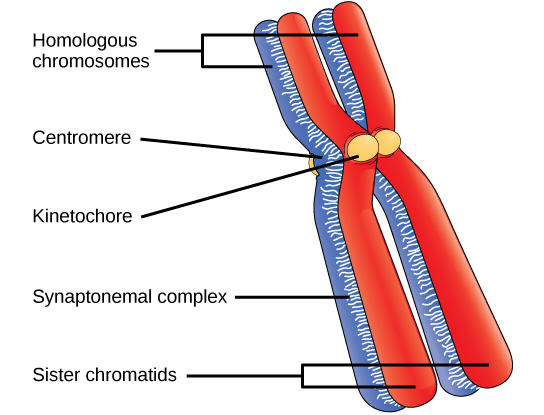
Located at intervals along the synaptonemal complex are large poly peptide assemblies called recombination nodules. These assemblies marking the points of later chiasmata and mediate the multistep process of crossover—or genetic recombination—betwixt the nonsister chromatids. About the recombination nodule, the double-stranded Dna of each chromatid is cleaved, the cut ends are modified, and a new connection is made betwixt the nonsister chromatids. As prophase I progresses, the synaptonemal circuitous begins to break down and the chromosomes begin to condense. When the synaptonemal circuitous is gone, the homologous chromosomes remain attached to each other at the centromere and at chiasmata. The chiasmata remain until anaphase I. The number of chiasmata varies according to the species and the length of the chromosome. There must be at least i chiasma per chromosome for proper separation of homologous chromosomes during meiosis I, but there may be every bit many every bit 25. Following crossover, the synaptonemal complex breaks down and the cohesin connection betwixt homologous pairs is removed. At the stop of prophase I, the pairs are held together only at the chiasmata ((Figure)). These pairs are called tetrads because the four sister chromatids of each pair of homologous chromosomes are now visible.
The crossover events are the starting time source of genetic variation in the nuclei produced by meiosis. A unmarried crossover event between homologous nonsister chromatids leads to a reciprocal commutation of equivalent DNA between a maternal chromosome and a paternal chromosome. When a recombinant sister chromatid is moved into a gamete cell information technology will conduct some DNA from one parent and some DNA from the other parent. The recombinant chromatid has a combination of maternal and paternal genes that did not be before the crossover. Crossover events can occur nigh anywhere forth the length of the synapsed chromosomes. Different cells undergoing meiosis volition therefore produce different recombinant chromatids, with varying combinations of maternal and parental genes. Multiple crossovers in an arm of the chromosome have the aforementioned effect, exchanging segments of Dna to produce genetically recombined chromosomes.
Crossover occurs betwixt nonsister chromatids of homologous chromosomes. The result is an exchange of genetic material between homologous chromosomes.
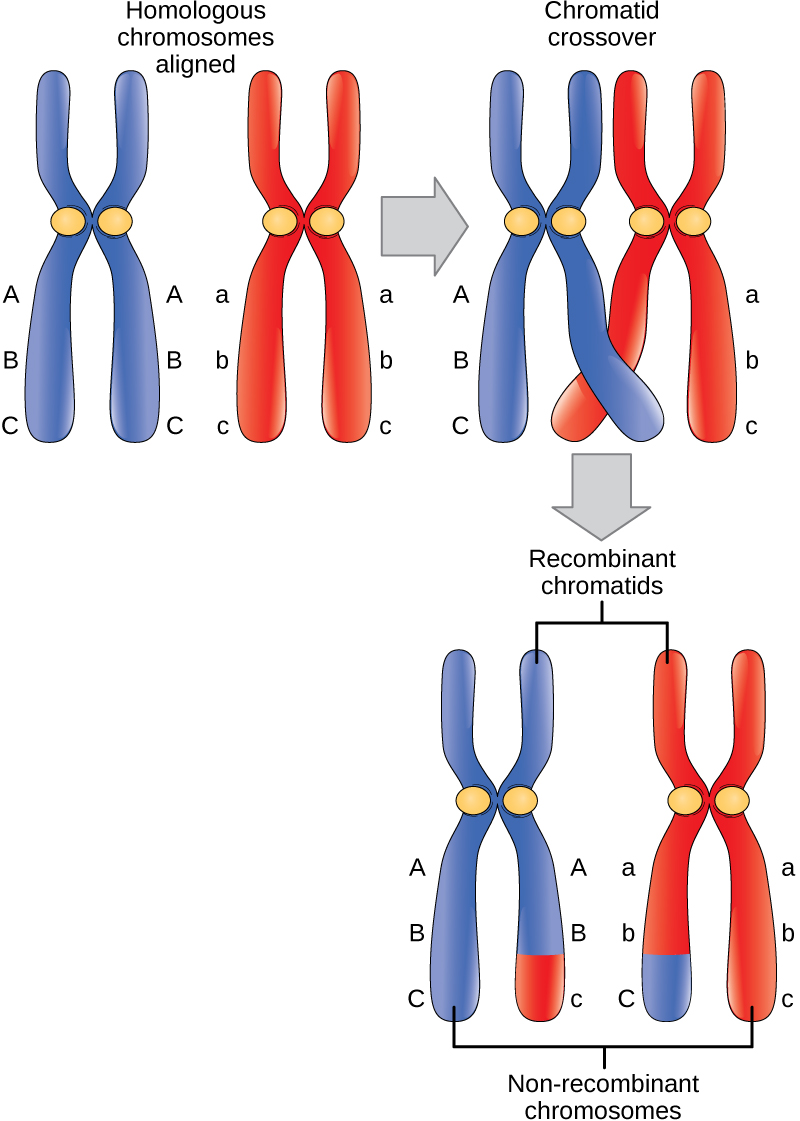
Prometaphase I
The key event in prometaphase I is the zipper of the spindle cobweb microtubules to the kinetochore proteins at the centromeres. Kinetochore proteins are multiprotein complexes that demark the centromeres of a chromosome to the microtubules of the mitotic spindle. Microtubules grow from microtubule-organizing centers (MTOCs). In beast cells, MTOCs are centrosomes located at contrary poles of the cell. The microtubules from each pole motility toward the middle of the prison cell and attach to one of the kinetochores of the two fused homologous chromosomes. Each member of the homologous pair attaches to a microtubule extending from contrary poles of the cell and then that in the adjacent phase, the microtubules tin pull the homologous pair autonomously. A spindle fiber that has attached to a kinetochore is called a kinetochore microtubule. At the terminate of prometaphase I, each tetrad is attached to microtubules from both poles, with one homologous chromosome facing each pole. The homologous chromosomes are yet held together at the chiasmata. In addition, the nuclear membrane has broken downwardly entirely.
Metaphase I
During metaphase I, the homologous chromosomes are arranged at the metaphase plate—roughly in the midline of the jail cell, with the kinetochores facing contrary poles. The homologous pairs orient themselves randomly at the equator. For example, if the two homologous members of chromosome 1 are labeled a and b, and so the chromosomes could line up a-b or b-a. This is important in determining the genes carried by a gamete, every bit each volition only receive one of the two homologous chromosomes. (Recollect that afterwards crossing over takes identify, homologous chromosomes are not identical. They comprise slight differences in their genetic information, causing each gamete to have a unique genetic makeup.)
The randomness in the alignment of recombined chromosomes at the metaphase plate, coupled with the crossing over events betwixt nonsister chromatids, are responsible for much of the genetic variation in the offspring. To analyze this further, remember that the homologous chromosomes of a sexually reproducing organism are originally inherited as two separate sets, ane from each parent. Using humans as an instance, i set of 23 chromosomes is present in the egg donated by the mother. The father provides the other set of 23 chromosomes in the sperm that fertilizes the egg. Every prison cell of the multicellular offspring has copies of the original ii sets of homologous chromosomes. In prophase I of meiosis, the homologous chromosomes form the tetrads. In metaphase I, these pairs line upward at the midway point between the ii poles of the jail cell to form the metaphase plate. Because in that location is an equal run a risk that a microtubule fiber will encounter a maternally or paternally inherited chromosome, the arrangement of the tetrads at the metaphase plate is random. Thus, whatever maternally inherited chromosome may face either pole. Likewise, whatever paternally inherited chromosome may also face either pole. The orientation of each tetrad is independent of the orientation of the other 22 tetrads.
This result—the random (or independent) array of homologous chromosomes at the metaphase plate—is the second mechanism that introduces variation into the gametes or spores. In each jail cell that undergoes meiosis, the arrangement of the tetrads is different. The number of variations is dependent on the number of chromosomes making up a prepare. At that place are 2 possibilities for orientation at the metaphase plate; the possible number of alignments therefore equals 2 n in a diploid prison cell, where n is the number of chromosomes per haploid set. Humans have 23 chromosome pairs, which results in over eight million (223) possible genetically-singled-out gametes simply from the random alignment of chromosomes at the metaphase plate. This number does not include the variability that was previously produced past crossing over betwixt the nonsister chromatids. Given these two mechanisms, it is highly unlikely that any two haploid cells resulting from meiosis will accept the same genetic composition ((Figure)).
To summarize, meiosis I creates genetically diverse gametes in two ways. Start, during prophase I, crossover events between the nonsister chromatids of each homologous pair of chromosomes generate recombinant chromatids with new combinations of maternal and paternal genes. Second, the random assortment of tetrads on the metaphase plate produces unique combinations of maternal and paternal chromosomes that will brand their way into the gametes.
Random, independent assortment during metaphase I can be demonstrated by because a prison cell with a set of ii chromosomes (n = 2). In this case, there are two possible arrangements at the equatorial airplane in metaphase I. The total possible number of different gametes is 2 northward , where n equals the number of chromosomes in a set. In this example, in that location are four possible genetic combinations for the gametes. With northward = 23 in man cells, at that place are over viii million possible combinations of paternal and maternal chromosomes.
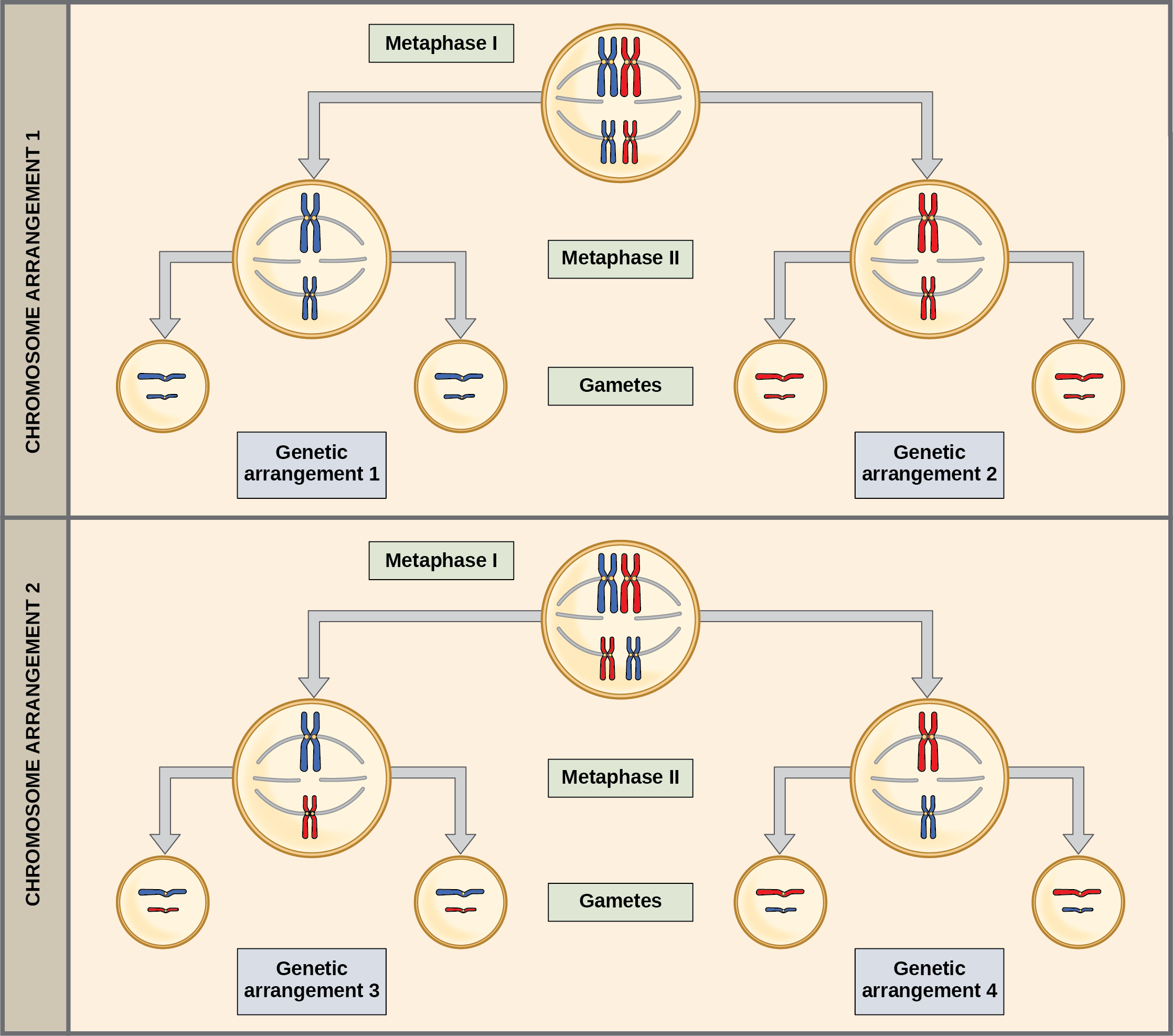
Anaphase I
In anaphase I, the microtubules pull the linked chromosomes apart. The sister chromatids remain tightly bound together at the centromere. The chiasmata are broken in anaphase I as the microtubules attached to the fused kinetochores pull the homologous chromosomes autonomously ((Figure)).
Telophase I and Cytokinesis
In telophase, the separated chromosomes arrive at opposite poles. The residue of the typical telophase events may or may non occur, depending on the species. In some organisms, the chromosomes "decondense" and nuclear envelopes course around the separated sets of chromatids produced during telophase I. In other organisms, cytokinesis—the physical separation of the cytoplasmic components into two girl cells—occurs without reformation of the nuclei. In about all species of animals and some fungi, cytokinesis separates the prison cell contents via a cleavage furrow (constriction of the actin band that leads to cytoplasmic partitioning). In plants, a cell plate is formed during cell cytokinesis by Golgi vesicles fusing at the metaphase plate. This jail cell plate will ultimately lead to the formation of cell walls that separate the two daughter cells.
Two haploid cells are the outcome of the start meiotic segmentation of a diploid prison cell. The cells are haploid considering at each pole, there is only one of each pair of the homologous chromosomes. Therefore, merely one full set of the chromosomes is present. This is why the cells are considered haploid—there is just one chromosome set, even though each chromosome still consists of 2 sis chromatids. Recall that sis chromatids are merely duplicates of i of the ii homologous chromosomes (except for changes that occurred during crossing over). In meiosis II, these two sis chromatids will carve up, creating four haploid daughter cells.
Meiosis Ii
In some species, cells enter a brief interphase, or interkinesis, before inbound meiosis II. Interkinesis lacks an Due south phase, and then chromosomes are not duplicated. The two cells produced in meiosis I go through the events of meiosis Ii in synchrony. During meiosis Ii, the sister chromatids within the two daughter cells separate, forming iv new haploid gametes. The mechanics of meiosis Two are similar to mitosis, except that each dividing cell has merely 1 prepare of homologous chromosomes, each with two chromatids. Therefore, each cell has one-half the number of sis chromatids to split up out every bit a diploid cell undergoing mitosis. In terms of chromosomal content, cells at the start of meiosis II are similar to haploid cells in Thou2, preparing to undergo mitosis.
Prophase II
If the chromosomes decondensed in telophase I, they condense again. If nuclear envelopes were formed, they fragment into vesicles. The MTOCs that were duplicated during interkinesis motion abroad from each other toward reverse poles, and new spindles are formed.
Prometaphase 2
The nuclear envelopes are completely cleaved down, and the spindle is fully formed. Each sis chromatid forms an individual kinetochore that attaches to microtubules from opposite poles.
Metaphase Ii
The sister chromatids are maximally condensed and aligned at the equator of the cell.
Anaphase Ii
The sister chromatids are pulled apart by the kinetochore microtubules and move toward opposite poles. Nonkinetochore microtubules elongate the cell.
The process of chromosome alignment differs between meiosis I and meiosis II. In prometaphase I, microtubules attach to the fused kinetochores of homologous chromosomes, and the homologous chromosomes are arranged at the midline of the prison cell (the metaphase plate) in metaphase I. In anaphase I, the homologous chromosomes separate. In prometaphase II, microtubules attach to the kinetochores of sister chromatids, and the sister chromatids are arranged at the midpoint of the cells in metaphase II. In anaphase Ii, the sister chromatids separate.
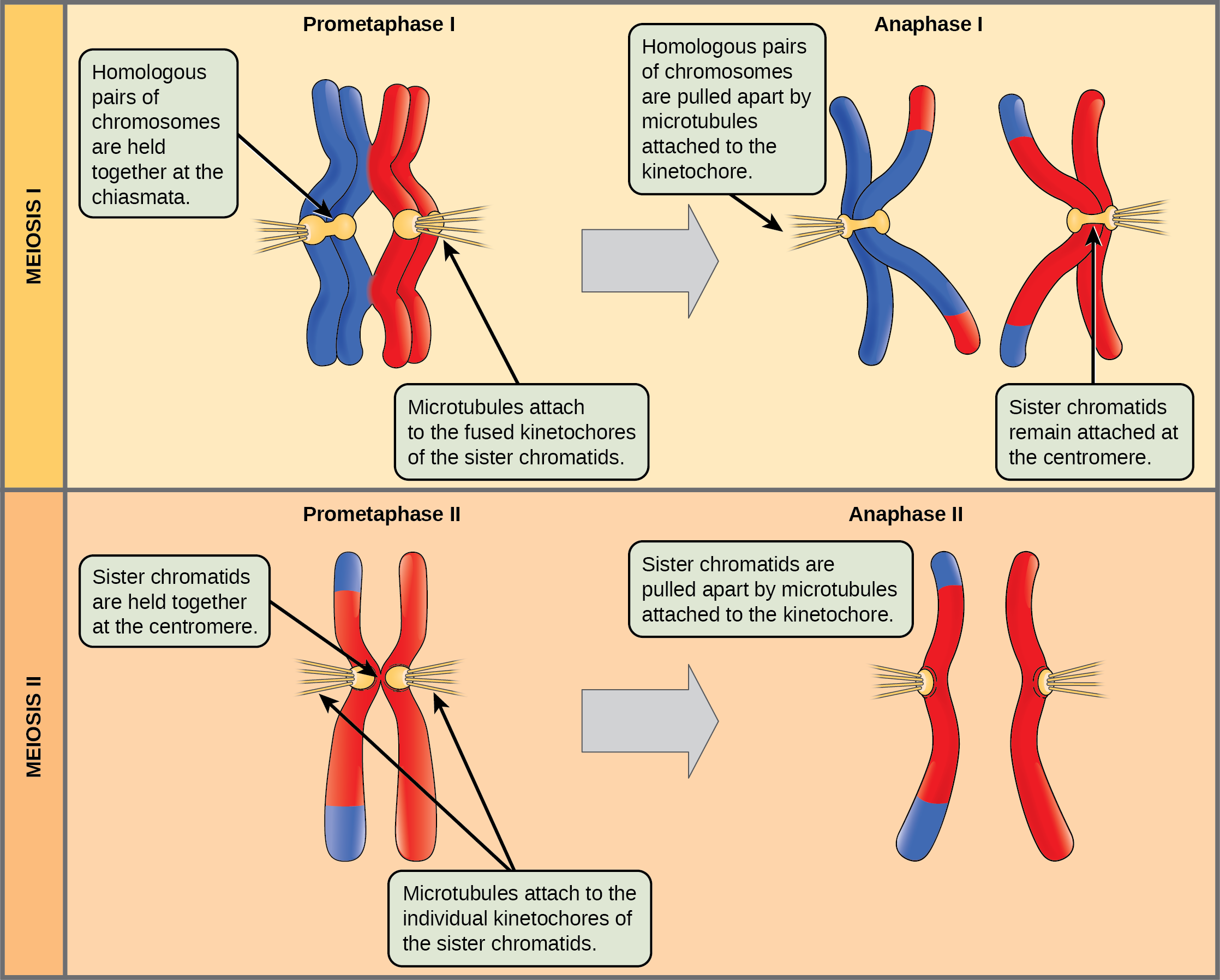
Telophase II and Cytokinesis
The chromosomes arrive at reverse poles and begin to decondense. Nuclear envelopes form around the chromosomes. If the parent prison cell was diploid, every bit is almost normally the case, then cytokinesis now separates the ii cells into four unique haploid cells. The cells produced are genetically unique because of the random assortment of paternal and maternal homologs and because of the recombination of maternal and paternal segments of chromosomes (with their sets of genes) that occurs during crossover. The unabridged process of meiosis is outlined in (Effigy).
An animal jail cell with a diploid number of four (2n = 4) gain through the stages of meiosis to grade four haploid daughter cells.
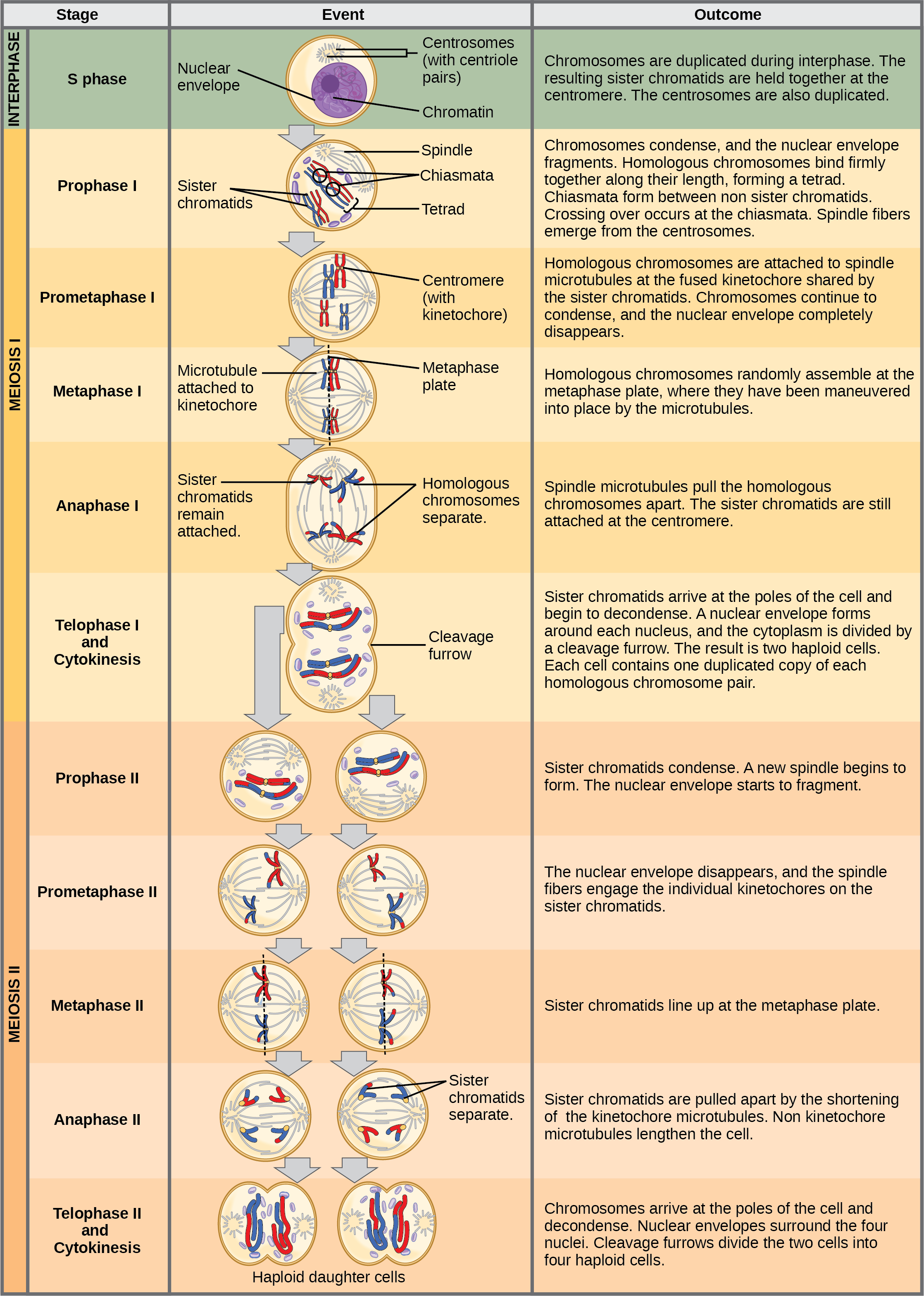
Comparing Meiosis and Mitosis
Mitosis and meiosis are both forms of sectionalization of the nucleus in eukaryotic cells. They share some similarities, but also exhibit a number of important and distinct differences that lead to very different outcomes ((Figure)). Mitosis is a single nuclear partition that results in two nuclei that are normally partitioned into ii new cells. The nuclei resulting from a mitotic segmentation are genetically identical to the original nucleus. They have the same number of sets of chromosomes: one set in the case of haploid cells and 2 sets in the case of diploid cells. In dissimilarity, meiosis consists of two nuclear divisions resulting in four nuclei that are usually partitioned into four new, genetically distinct cells. The iv nuclei produced during meiosis are non genetically identical, and they incorporate one chromosome set only. This is half the number of chromosome sets in the original cell, which is diploid.
The main differences between mitosis and meiosis occur in meiosis I, which is a very different nuclear division than mitosis. In meiosis I, the homologous chromosome pairs physically meet and are bound together with the synaptonemal circuitous. Following this, the chromosomes develop chiasmata and undergo crossover between nonsister chromatids. In the end, the chromosomes line upwardly along the metaphase plate as tetrads—with kinetochore fibers from opposite spindle poles attached to each kinetochore of a homolog to course a tetrad. All of these events occur merely in meiosis I.
When the chiasmata resolve and the tetrad is broken up with the homologs moving to i pole or another, the ploidy level—the number of sets of chromosomes in each future nucleus—has been reduced from two to i. For this reason, meiosis I is referred to every bit a reductional division. At that place is no such reduction in ploidy level during mitosis.
Meiosis 2 is analogous to a mitotic sectionalisation. In this instance, the duplicated chromosomes (only one ready of them) line up on the metaphase plate with divided kinetochores fastened to kinetochore fibers from opposite poles. During anaphase II, equally in mitotic anaphase, the kinetochores divide and ane sis chromatid—now referred to as a chromosome—is pulled to one pole while the other sister chromatid is pulled to the other pole. If it were not for the fact that at that place had been crossover, the two products of each individual meiosis 2 partition would be identical (equally in mitosis). Instead, they are unlike considering in that location has always been at to the lowest degree one crossover per chromosome. Meiosis II is not a reduction partitioning because although there are fewer copies of the genome in the resulting cells, there is still one set of chromosomes, as at that place was at the finish of meiosis I.
Meiosis and mitosis are both preceded by one cycle of DNA replication; however, meiosis includes two nuclear divisions. The four girl cells resulting from meiosis are haploid and genetically singled-out. The girl cells resulting from mitosis are diploid and identical to the parent jail cell.
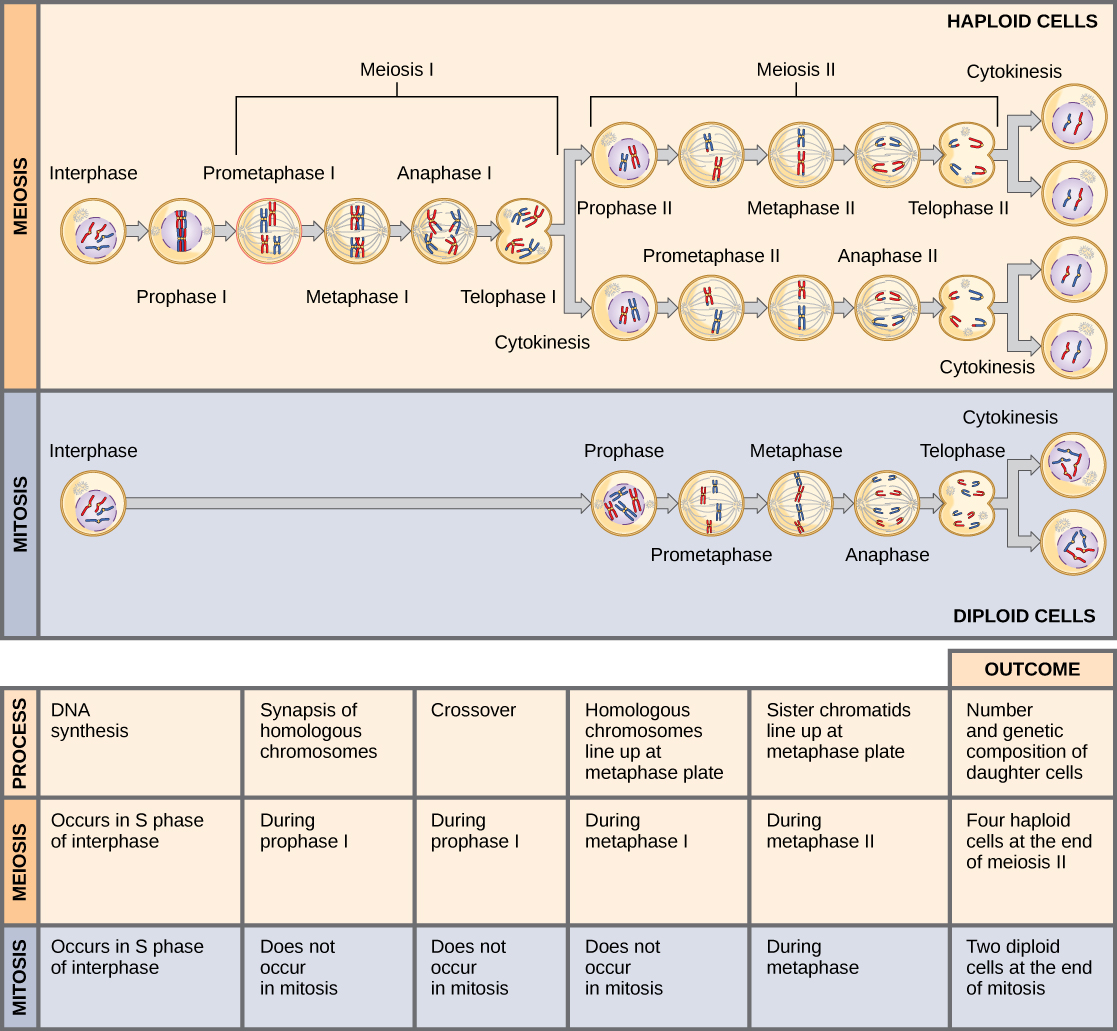
Evolution Connection
The Mystery of the Development of MeiosisSome characteristics of organisms are then widespread and primal that it is sometimes hard to call back that they evolved like other simple traits. Meiosis is such an extraordinarily complex series of cellular events that biologists have had problem testing hypotheses apropos how information technology may have evolved. Although meiosis is inextricably entwined with sexual reproduction and its advantages and disadvantages, it is important to separate the questions of the evolution of meiosis and the evolution of sex, because early on meiosis may have been advantageous for unlike reasons than information technology is at present. Thinking outside the box and imagining what the early on benefits from meiosis might have been is one approach to uncovering how information technology may have evolved.
Meiosis and mitosis share obvious cellular processes, and information technology makes sense that meiosis evolved from mitosis. The difficulty lies in the clear differences betwixt meiosis I and mitosis. Adam Wilkins and Robin Hollidayi summarized the unique events that needed to occur for the development of meiosis from mitosis. These steps are homologous chromosome pairing and synapsis, crossover exchanges, sister chromatids remaining attached during anaphase, and suppression of Dna replication in interphase. They argue that the get-go stride is the hardest and nigh important and that agreement how it evolved would brand the evolutionary process clearer. They advise genetic experiments that might shed low-cal on the evolution of synapsis.
At that place are other approaches to understanding the evolution of meiosis in progress. Unlike forms of meiosis exist in unmarried-celled protists. Some appear to be simpler or more than "primitive" forms of meiosis. Comparing the meiotic divisions of different protists may shed calorie-free on the development of meiosis. Marilee Ramesh and colleagues 2 compared the genes involved in meiosis in protists to understand when and where meiosis might have evolved. Although enquiry is even so ongoing, contempo scholarship into meiosis in protists suggests that some aspects of meiosis may accept evolved later than others. This kind of genetic comparing can tell united states of america what aspects of meiosis are the oldest and what cellular processes they may have borrowed from in before cells.
Link to Learning
Click through the steps of this interactive animation to compare the meiotic process of cell division to that of mitosis at How Cells Split up.
Section Summary
Sexual reproduction requires that organisms produce cells that can fuse during fertilization to produce offspring. In most animals, meiosis is used to produce haploid eggs and sperm from diploid parent cells so that the fusion of an egg and sperm produces a diploid zygote. As with mitosis, Deoxyribonucleic acid replication occurs prior to meiosis during the South-stage of the cell wheel and then that each chromosome becomes a pair of sister chromatids. In meiosis, there are two rounds of nuclear division resulting in four nuclei and normally 4 daughter cells, each with half the number of chromosomes as the parent jail cell. The first division separates homologs, and the second—like mitosis—separates chromatids into individual chromosomes. Meiosis generates variation in the daughter nuclei during crossover in prophase I as well as during the random alignment of tetrads at metaphase I. The cells that are produced by meiosis are genetically unique.
Meiosis and mitosis share similar processes, but have distinct outcomes. Mitotic divisions are single nuclear divisions that produce genetically identical girl nuclei (i.east., each daughter nucleus has the same number of chromosome sets as the original cell). In contrast, meiotic divisions include two nuclear divisions that ultimately produce four genetically unlike daughter nuclei that have merely 1 chromosome fix (instead of the ii sets of chromosomes in the parent cell). The main differences between the two nuclear division processes have identify during the offset division of meiosis: homologous chromosomes pair, crossover, and exchange homologous nonsister chromatid segments. The homologous chromosomes divide into dissimilar nuclei during meiosis I, causing a reduction of ploidy level in the first division. The second sectionalization of meiosis is similar to a mitotic division, except that the daughter cells do non incorporate identical genomes because of crossover and chromosome recombination in prophase I.
Review Questions
Meiosis usually produces ________ daughter cells.
- two haploid
- ii diploid
- four haploid
- four diploid
C
What structure is nearly important in forming the tetrads?
- centromere
- synaptonemal complex
- chiasma
- kinetochore
B
At which stage of meiosis are sister chromatids separated from each other?
- prophase I
- prophase Ii
- anaphase I
- anaphase 2
D
At metaphase I, homologous chromosomes are connected but at what structures?
- chiasmata
- recombination nodules
- microtubules
- kinetochores
A
Which of the following is non true in regard to crossover?
- Spindle microtubules guide the transfer of DNA across the synaptonemal circuitous.
- Nonsister chromatids exchange genetic material.
- Chiasmata are formed.
- Recombination nodules marker the crossover indicate.
C
What phase of mitotic interphase is missing from meiotic interkinesis?
- G0 phase
- One thousandone phase
- S stage
- G2 stage
C
The part of meiosis that is similar to mitosis is ________.
- meiosis I
- anaphase I
- meiosis II
- interkinesis
C
If a muscle cell of a typical organism has 32 chromosomes, how many chromosomes will be in a gamete of that same organism?
- 8
- xvi
- 32
- 64
B
Which statement all-time describes the genetic content of the two girl cells in prophase II of meiosis?
- haploid with one copy of each cistron
- haploid with ii copies of each gene
- diploid with two copies of each factor
- diploid with iv copies of each factor
B
The pea plants used in Mendel's genetic inheritance studies were diploid, with 14 chromosomes in somatic cells. Assuming no crossing over events occur, how many unique gametes could i pea plant produce?
- 28
- 128
- 196
- xvi,384
B
How do telophase I and telophase II differ during meiosis in animal cells?
- Cells remain diploid at the end of telophase I, but are haploid at the end of telophase 2.
- Daughter cells course a cell plate to divide during telophase I, but divide by cytokinesis during telophase 2.
- Cells enter interphase after telophase I, but not after telophase II.
- Chromosomes can remain condensed at the stop of telophase I, only decondense after telophase Two.
D
Critical Thinking Questions
Describe the procedure that results in the formation of a tetrad.
During the meiotic interphase, each chromosome is duplicated. The sis chromatids that are formed during synthesis are held together at the centromere region by cohesin proteins. All chromosomes are fastened to the nuclear envelope past their tips. As the jail cell enters prophase I, the nuclear envelope begins to fragment and the proteins property homologous chromosomes locate each other. The four sister chromatids align lengthwise, and a protein lattice chosen the synaptonemal complex is formed between them to bind them together. The synaptonemal circuitous facilitates crossover betwixt nonsister chromatids, which is observed every bit chiasmata along the length of the chromosome. As prophase I progresses, the synaptonemal circuitous breaks downwardly and the sister chromatids get free, except where they are attached by chiasmata. At this stage, the four chromatids are visible in each homologous pairing and are called a tetrad.
Explain how the random alignment of homologous chromosomes during metaphase I contributes to the variation in gametes produced by meiosis.
Random alignment leads to new combinations of traits. The chromosomes that were originally inherited by the gamete-producing individual came every bit from the egg and the sperm. In metaphase I, the duplicated copies of these maternal and paternal homologous chromosomes line upwards beyond the center of the prison cell. The orientation of each tetrad is random. At that place is an equal run a risk that the maternally derived chromosomes will be facing either pole. The same is true of the paternally derived chromosomes. The alignment should occur differently in almost every meiosis. As the homologous chromosomes are pulled apart in anaphase I, any combination of maternal and paternal chromosomes will move toward each pole. The gametes formed from these two groups of chromosomes will have a mixture of traits from the private's parents. Each gamete is unique.
What is the function of the fused kinetochore constitute on sis chromatids in prometaphase I?
In metaphase I, the homologous chromosomes line upward at the metaphase plate. In anaphase I, the homologous chromosomes are pulled apart and move to reverse poles. Sister chromatids are non separated until meiosis Ii. The fused kinetochore formed during meiosis I ensures that each spindle microtubule that binds to the tetrad will attach to both sister chromatids.
In a comparison of the stages of meiosis to the stages of mitosis, which stages are unique to meiosis and which stages take the same events in both meiosis and mitosis?
All of the stages of meiosis I, except possibly telophase I, are unique because homologous chromosomes are separated, non sister chromatids. In some species, the chromosomes practise non decondense and the nuclear envelopes do not grade in telophase I. All of the stages of meiosis II accept the same events equally the stages of mitosis, with the possible exception of prophase 2. In some species, the chromosomes are still condensed and there is no nuclear envelope. Other than this, all processes are the same.
Why would an individual with a mutation that prevented the formation of recombination nodules be considered less fit than other members of its species?
The chromosomes of the individual cannot cross over during meiosis if the private cannot brand recombination nodules. This limits the genetic diversity of the private's gametes to what occurs during independent assortment, with all daughter cells receiving complete maternal or paternal chromatids. An individual who cannot produce various offspring is considered less fit than individuals who do produce diverse offspring.
Does crossing over occur during prophase II? From an evolutionary perspective, why is this advantageous?
Crossing over does not occur during prophase II; information technology merely occurs during prophase I. In prophase Two, in that location are still two copies of each gene, but they are on sis chromatids within a single chromosome (rather than homologous chromosomes as in prophase I). Therefore, whatever crossover outcome would nonetheless produce two identical chromatids. Because information technology is advantageous to avert wasting free energy on events that volition non increase genetic diversity, crossing over does non occur.
Footnotes
- 1 Adam S. Wilkins and Robin Holliday, "The Evolution of Meiosis from Mitosis," Genetics 181 (2009): 3–12.
- 2 Marilee A. Ramesh, Shehre-Banoo Malik and John M. Logsdon, Jr, "A Phylogenetic Inventory of Meiotic Genes: Evidence for Sex in Giardia and an Early Eukaryotic Origin of Meiosis," Current Biology 15 (2005):185–91.
Glossary
- chiasmata
- (singular, chiasma) the structure that forms at the crossover points later on genetic material is exchanged
- cohesin
- proteins that course a circuitous that seals sister chromatids together at their centromeres until anaphase 2 of meiosis
- crossover
- commutation of genetic material betwixt nonsister chromatids resulting in chromosomes that incorporate genes from both parents of the organism
- fertilization
- union of two haploid cells from two individual organisms
- interkinesis
- (also, interphase II) cursory menstruum of rest between meiosis I and meiosis II
- meiosis
- a nuclear division process that results in four haploid cells
- meiosis I
- starting time circular of meiotic cell partitioning; referred to as reduction division because the ploidy level is reduced from diploid to haploid
- meiosis 2
- 2d round of meiotic prison cell division post-obit meiosis I; sis chromatids are separated into individual chromosomes, and the event is four unique haploid cells
- recombination nodules
- protein assemblies formed on the synaptonemal complex that mark the points of crossover events and mediate the multistep process of genetic recombination between nonsister chromatids
- reduction division
- nuclear division that produces daughter nuclei each having half every bit many chromosome sets every bit the parental nucleus; meiosis I is a reduction sectionalization
- somatic cell
- all the cells of a multicellular organism except the gametes or reproductive cells
- spore
- haploid prison cell that can produce a haploid multicellular organism or tin can fuse with another spore to course a diploid cell
- synapsis
- formation of a close association betwixt homologous chromosomes during prophase I
- synaptonemal complex
- protein lattice that forms between homologous chromosomes during prophase I, supporting crossover
- tetrad
- 2 duplicated homologous chromosomes (four chromatids) bound together by chiasmata during prophase I
Source: https://opentextbc.ca/biology2eopenstax/chapter/the-process-of-meiosis/
Posted by: bridgesshen1994.blogspot.com

0 Response to "How Do Telophase I And Telophase Ii Differ During Meiosis In Animal Cells?"
Post a Comment